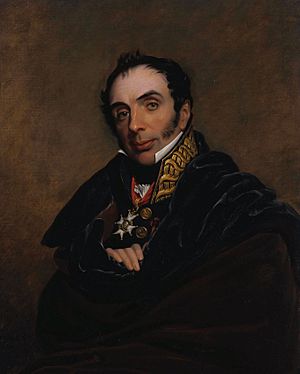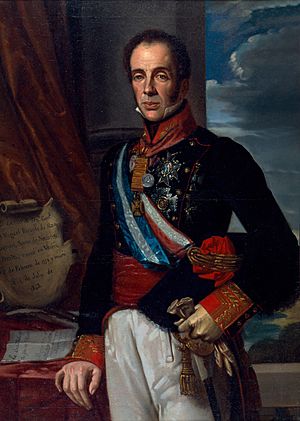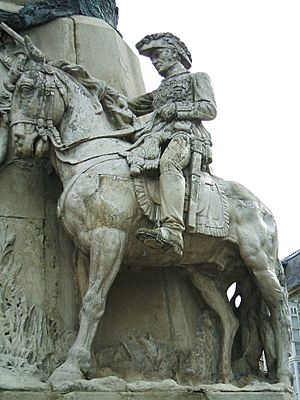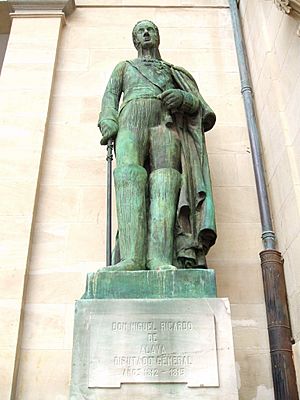Miguel Ricardo de Álava facts for kids
Quick facts for kids
The Most Excellent
Miguel Ricardo de Álava
KCB MWO
|
|
|---|---|

Portrait by George Dawe, 1818
|
|
| Prime Minister of Spain | |
| In office 14 September 1835 – 25 September 1835 |
|
| Monarch | Isabella II |
| Preceded by | The Count of Toreno |
| Succeeded by | Juan Álvarez Mendizábal |
| Personal details | |
| Born | 7 July 1770 Vitoria-Gasteiz, Álava, Spain |
| Died | 14 July 1843 (aged 73) Barèges, France |
| Military service | |
| Rank | Brigadier General |
| Battles/wars | War of the Third Coalition |
Miguel Ricardo de Álava y Esquivel (born July 7, 1770 – died July 14, 1843) was an important Spanish General and politician. He even served as the Prime Minister of Spain for a short time in 1835. Miguel de Álava was born in Vitoria-Gasteiz, in the Basque Country of Spain. What makes him really special is that he was present at two very famous battles: the Battle of Trafalgar and the Battle of Waterloo. He fought against the British at Trafalgar, but then fought alongside them at Waterloo!
Álava started his career in the Spanish Navy. He was an aide-de-camp (a personal assistant to a senior officer) when Spain was allied with France. However, in 1808, when Napoleon invaded Spain, Álava changed sides. He joined the Spanish forces fighting against the French. The Spanish government sent him to work with the British Army. There, he became an aide-de-camp to Wellesley, who later became the Duke of Wellington. Wellington liked Álava a lot. By the end of the war, Álava had become a brigadier-general. In 1815, during the Waterloo Campaign, Álava was the Spanish ambassador in The Hague. This allowed him to be with Wellington during the Battle of Waterloo.
Contents
Miguel de Álava was born into a noble family with a strong history in the navy. His father was Pedro Jacinto de Álava y Navarrete. His mother was María Manuela de Esquível y Peralta. His uncle, Ignacio María de Álava, was a famous naval officer. He became the Captain General of the Navy in 1817.

From 1781 to 1790, Miguel studied at the Vergara Seminary. This school was for the sons of noble families. In 1785, at just 13 years old, he joined the Infantry Regiment of Seville. His other uncle, José de Álava, led this regiment. Miguel became a second lieutenant in 1787.
After his time in the infantry, Álava joined the Navy in 1790. He was likely inspired by his uncle Ignacio. He served on different ships and took part in many battles against France and England. These battles were in places like Ceuta, the Siege of Toulon, and Italy. Because of his actions and his family connections, he quickly rose through the ranks. By 1794, he was a frigate lieutenant.
In 1795, he went on an expedition with his uncle Ignacio that aimed to travel around the world. He stayed in South America until 1800. Álava was captured by the English on his way back to Spain. He was released a few months later. In 1801, he returned to Spain. In 1802, he was stationed in Cádiz and was promoted to lieutenant of the ship.
In 1805, he returned to Cádiz and joined the fleet led by Admiral Gravina. He took part in the Battle of Trafalgar on October 21, 1805. He was on the ship Príncipe de Asturias with Admiral Gravina. His uncle Ignacio was on the ship Santa Ana. After this important battle, Álava was promoted again.
Fighting in the Peninsular War
After the Battle of Trafalgar, Álava moved from the Navy to the Army. He kept a similar rank. In 1808, when the Spanish people rose up against the French invasion, Álava joined them. He fought alongside the British forces in Spain.

In 1810, he was sent to Portugal to tell Wellington about the difficult situation against the French. During this time, a strong friendship grew between Wellington and Álava. Wellington even asked Álava to stay as the Spanish representative with the British units. Wellington personally recommended that Álava be promoted to Brigadier. Álava fought in many important battles. These included the Battle of Salamanca, Battle of Vitoria, and Battle of Bussaco. He also took part in the Siege of Ciudad Rodrigo and the Siege of Badajoz. For his service, he was made an honorary Knight Commander of the Order of the Bath.
The Battle of Waterloo

When King Ferdinand VII returned to power, Álava was put in prison. However, his uncle Ethenard and Wellington helped him get released quickly. Álava soon gained the King's favor. In 1815, the King made him ambassador to The Hague (a city in the Netherlands). Because of this, he was able to be at the Battle of Waterloo with Wellington's staff.
Álava stayed very close to the Duke during the battle. Like Wellington, Álava survived the battle without any injuries. This was amazing because Wellington and his staff were in the middle of the fighting. Wellington even told Álava, "The hand of Almighty God has been upon me this day." Álava is believed to be the only person on the Coalition side who was present at both the Battle of Waterloo and the Battle of Trafalgar.
Politician and Diplomat
When the revolution of 1820 began, Álava was chosen to represent his home province in the Cortes (the Spanish parliament). He became a leader in the "Exaltados" party. In 1822, he became President of the Cortes. He fought to protect the power of the Cortes against rebels.
When the French army surrounded Cádiz, Álava was chosen to negotiate with the French leader. The talks led to King Ferdinand being restored to power. The King promised to follow a more liberal policy. However, once the King was back in charge, he broke his promises. Álava had to leave Spain. He went to Gibraltar and then to England. In England, the Duke of Wellington gave him a house on his estate. Wellington also told his bank to give Álava any money he needed.
After King Ferdinand died, Álava returned to Spain. He supported Maria Christina against Don Carlos. He was appointed ambassador to London in 1834 and to Paris in 1835. In September 1835, he was offered the job of Prime Minister, but he turned it down. After another political uprising, he refused to sign the new constitution of 1837. He said he was tired of taking new oaths. Because of this, he had to retire to France, where he died in Barèges in 1843.
Legacy and Recognition
Miguel de Álava had many important friends and contacts. These connections came from his time as a military officer and as an ambassador. His relationships often went beyond just work. For example, in 1813, William II of the Netherlands, who fought with him, congratulated him on his upcoming marriage. Even the French Queen, María Amalia, wrote to him about family matters.
However, the Duke of Wellington was probably Álava's greatest admirer and friend. Álava earned Wellington's trust when he served as his aide-de-camp during the fight against the French.
A historical novel about General Álava's role as Wellington's aide-de-camp at the Battle of Waterloo was written by Ildefonso Arenas. It is called Álava en Waterloo and was published in 2012. Álava is often mentioned in books about the Duke of Wellington and in Wellington's own letters.
Today, there are three monuments dedicated to him in Vitoria, Spain. These include the Monument to the Battle of Vitoria in Plaza de la Virgen Blanca and two statues. One statue is at the Diputación Foral de Álava and the other is at the Museum of the Armoury.
Images for kids
-
Equestrian statue of the General in the Monument to the Battle of Vitoria (1813), Vitoria, Spain
See also
 In Spanish: Miguel Ricardo de Álava para niños
In Spanish: Miguel Ricardo de Álava para niños



